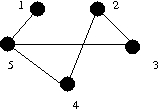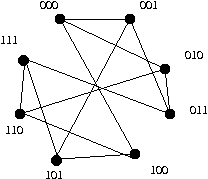
|

|

|

|

|

|

| ||
| G1 | G2 | X3 |
{ 23, 45 }
ab, ac, ae, bd, bf, cd, cf
000 001, 000 010, 000 100, 011 010, 011 001, 011 111.
G1: { 2, 5 }
G2: { b, c }
Q3: There is no cut set of size 2 as the graph is 3-connected.
G1: { 35, 45 }
G2: { bd, cd }
Q3: There is no edge cut set of size 2 as the graph is 3-edge connected.
K(G1) = 1 as 5 is an articulation point.
K(G2) = 2 { b, c } is a cut set, but every point lies on a cycle.
K(Q3) = 3 As noted there is no 2 cut set, but { 000, 011, 101 } is a cut set.
K'(G1) = 1, as 15 is a cut edge.
K'(G2) = 2, { db, dc } is a cut set, but every point lies on a cycle.
K'(Q3) = 3, As noted there is no 2 edge cut set, but { 000 001, 000 010, 000 100 } is a cut set.
3 in each case.
Note that since the Peterson graph is 3-regular we know that the vertex
and edge connectivity are the same.
Since the minimum degree δ = 3, we know that they are at most three.
Use the symmetry of the graph to argue that no 2-edge cut can disconnect the graph.
Kn, Km,n, Pn, Cn, peterson.



By the definition of internal d(v) > 1, so v has at least two neighbors
in T, u1 and u2 say.
But since T is a tree there is a unique path from u1 to
u2, which must be { u1, v, u2 }
Now T - v has no u1 u2--path, and so is
disconnected.
Let T be a tree and v a leaf of T.
By the definition of leaf d(v) = 1, so v has exactly one neighbor,
u say.
Let x and y be any pair of vertices in T - v.
Since T is a tree there is a unique xy--path in T, P say.
The degree of an internal vertex of a path must be at least 2, but the degree of
v is one, so v does not appear as an internal vertex of P.
Thus P only contains vertices in T - v and so connects
x and y in T - v.
Let G be a connected graph with at least three vertices.
Let G' be formed from G by adding an edge between every pair of
vertices which are distance 2 apart in G.
Clearly any cut vertex of G' is also a cut vertex of G since we have
only added edges.
Suppose u is a cut vertex of G and let x and y be in different components of
G - u.
Since G is connected there must be an paths from x to u and v to w
where v and w are neighbors of u.
But since v and w are both neighbors of u they are distance 2 apart in G
and so have an edge between them in G'.
Thus there is an xy-path in G - u.